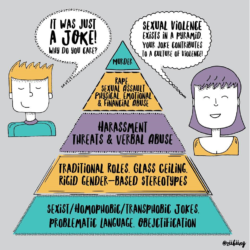
What can we do about gendered violence?
Just a heads up – this blog post will discuss domestic and sexual violence. If this topic raises issues for you, you might like to click away.
If you or someone you know is in immediate danger, call 000.
Support for sexual assault and family and domestic violence is available at 1800 RESPECT. They offer confidential counselling via phone and webchat, available 24 hours a day, seven days a week. Phone: 1800 737 732.
The stats
- 1 woman is killed every single week on average in Australia, at the hands of her current or former male partner. Roughly 1 man dies each month at the hands of an intimate partner.
- 1 in 6 Australian women have experienced physical or sexual violence from a current or former intimate partner, not including boyfriends or dates. Men experience physical or sexual violence from their cohabitating intimate partners at a rate of 1 in 16.
- Approximately 1 in 4 women have experienced violence by an intimate partner, compared to 1 in 13 men, including girlfriends/boyfriends/dates that are not cohabitating.
- 1 in 5 Australian women and 1 in 20 Australian men have experienced sexual violence.
- More than 4 in 5 (85%) Australian women and over half (56%) of Australian men over the age of 15 have been sexually harassed at some point in their lifetimes.
These statistics are horribly shocking. That’s a lot of affected people that we may know and interact with every day. We end up feeling equal parts numb, helpless and outraged when we see the news and hear that another woman has died due to intimate partner violence. It leaves us wondering if there is anything we can do to stop it.
Many statistics distinguish between physical and sexual violence, violence experienced from current or formers partners, violence experienced from strangers, emotional abuse, sexual harassment and more. For more statistics, check out the ABS Personal Safety Survey Report, Human Rights Commission, 2018 and Our Watch’s facts and figures.
As you can see above, the statistics include violence and harassment against men and rightly so. All violence and abuse is a problem, there is no denying that, but we can see it happens significantly more often for women. This article will discuss how we can make an impact on violence against women, as it is something rooted far more deeply in gender inequality.
The source of the problem
Domestic and sexual violence does not exist in a vacuum. We don’t have more than 52 women dying each and every year without some serious underlying societal problems.
Very simply, the problem begins with gender inequality. Gender inequality is created and maintained by sexist attitudes, gendered stereotypes, and objectification.
The pyramid of gendered violence shows how sexist attitudes lie at the bottom of escalating levels of abuse.

Our Watch found in their Change the Story report (page 8) that the most consistent drivers of violence against women are expressions of gender inequality. They are:
- Condoning violence against women
- Men’s control of decision-making and limits to women’s decision-making and independence in public and private life
- Rigid gender roles and stereotyped constructions of masculinity and femininity
- Male peer relations that emphasise aggression and disrespect towards women.
In November 2019, research by Our Watch revealed that men who endorse dominant ideas of masculinity are more likely to commit acts of violence, bullying and sexual harassment (Men in Focus, 2019). Dominant ideas of masculinity include notions that men must be strong and have a high sex drive, provide for their families, but always have beers with the boys and show no emotions.
These ideas of masculinity don’t leave men a lot of room to be who they truly are or how they are truly feeling. It’s obvious then that gendered stereotypes, including this dominant idea of masculinity, aren’t helping men or women.
This video by Our Watch provides a great explanation of how these drivers can fuel violence against women:
What can we do about it?
Statistically speaking, not many people murder their partners. Many more of us are likely to be unwittingly using problematic language or objectify others. That is the area in which the greatest change can be made. Tackling gendered violence is about making changes at the bottom of the pyramid. If we all do a little bit, it can help to eliminate the drivers of violence.
Our Watch (Change the Story, page 9) recommended 5 essential actions to reducing the gendered drivers of violence against women.
- Challenge condoning of violence against women
- Promote women’s independence and decision-making in public life and relationships
- Foster positive personal identities and challenge gender stereotypes and roles
- Strengthen positive, equal and respectful relations between and among women and men, girls and boys
- Promote and normalise gender equality in public and private life
What does this look like in practice?
Firstly, have a careful think about your own attitudes. For many of us, we have been raised in environments where gendered inequality is perpetuated. In society, gendered stereotypes, inequality, and sexism are all around us. Sometimes words slip out of your mouth before your brain can even think them. But ultimately, we can only control ourselves.
If we can be aware of our own attitudes and biases, we can make an effort to be careful about what we say. And if you mess up, just correct yourself.
When it comes to others, very simply, don’t ignore sexist statements or attitudes. Don’t shy away from pointing out that gendered stereotypes are outdated, unhelpful and harmful. Challenge these attitudes. If we all say something, it will lead to greater change. It is possible to challenge without being aggressive. How you address the issue might depend on who you are speaking to, but the bottom line is that we need to challenge sexist and gendered attitudes.
Speak out against the condoning of violence
Here are some examples of statements that condone gendered violence and what you could say in response,
- “Look at what she is wearing, she’s asking for it” → “What someone wears has nothing to do with whether they want to be touched or have sex.”
- “She must have done something to make him pretty angry” → “It is not appropriate to use violence at all, regardless of how you feel.”
Speak out against gendered stereotypes
Gendered stereotypes are a big one. You could probably rattle off a long list of stereotypes. Men are strong, logical and unemotional. Women are emotional and are more suited to caring professions. Women are best to stay at home with their children. Men are under the thumb of their controlling wives. Women nag their husbands. There is a lot that can be said in response to these stereotypes.
Breaking down the stereotypes means we need to consider all sides, not just the stereotypes about women. Some of us have probably already spoken out against a gendered stereotype against a woman.
But we need to do the same with stereotypes about men. Give the men in your life space to express themselves, to be caring, to want to stay home with their children, to be equal contributors to household chores. For a statement like “Don’t cry like a girl”, you could respond with “Men are allowed to cry too, it’s not ‘girly’.”
We can do something about domestic and sexual violence. It starts right here, in the attitudes we hold and the way we treat each other. It can be changed by holding ourselves and others to a higher standard. The power to make change is in all of our hands.
If you have experienced or are experiencing domestic or sexual violence, there are a range of services available.
- UNE students can access free counselling through UNE Student Counselling and Psychological Services (CAPS). They are fully qualified and registered psychologists, offering on-campus appointments and phone/video chat sessions for online students. The service is confidential and free for UNE students.You can contact them Monday- Friday, 9am-4 pm, on (02) 6773 2897.
- For more urgent assistance, UNE offers After Hours Support on weekdays from 4.00pm to 9.00am AEST, weekends and public holidays. Phone 1300 661 927 or text 0488 884 169. Alternatively, you can contact Lifeline on 13 11 14.
External support
- 1800 RESPECT. Confidential sexual assault and family and domestic violence counselling via phone and webchat. Available 24 hours a day, seven days a week. Phone: 1800 737 732.
- NSW Rape Crisis. 24/7 telephone and online crisis counselling service for anyone in NSW – men, women and non-binary – who has experienced or is at risk of sexual assault and their non-offending supporters. Phone: 1800 424 017.
Our team at Advocacy & Welfare is here to help you when you need – if you need to talk with someone, and you’re not sure which direction to go, please reach out to our team.
You’re never alone at UNE.


